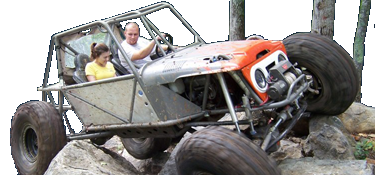So why not just put the diff in the middle... like a normal independent suspension rig
Travel. Clean travel. Ground clearance.
Bc then you can only get the a arms so long and the diff from flange to flange only so narrow.
This way allows longer a arms, more ground clearance, and better geometry through travel.
Only center width necessary would be to mount the arms and get a carrier bearing for the driver side shaft between the first two of 3 cvs.
I'm pretty skeptical of that design, just from looking at the one picture. It's a clever setup, but not without some compromises for everything but crawling.
It seems the only advantage would be to to limit the axle joint angles by spreading the angle over multiple joints, and maybe the secondary benefit of offsetting the driveshaft to the side of the chassis (if that's even an issue). Everything else is a detriment on that setup it would appear. The driveshaft location doesn't even matter that much, because you still have a stationary shaft with a fixed diff housing in an IRS setup.
You're adding a shitload of unsprung mass to the arm on that side only (from the housing, carrier, and some percentage of the driveshaft), so you've now got an asymmetric suspension setup, with different spring and damping requirements for the left and right, and inherently different response. That's mostly a problem at mid to high speeds, and not for crawling obviously.
I'm trying to wrap my head around what is happening with the torque reaction on the right side versus the left as well.
You're also trading center ground clearance for right side ground clearance. You've still got a housing that limits ground clearance, you've just moved where it is and changed where the clearance problem is during suspension travel. The housing is still going to be the lowest point between the wheels during many combinations of wheel travel.
I can't see what there is for trailing arms or whatever in side view, but hopefully there is something to adequately protect the driveshaft. Else it could be very, very exposed. It's almost always going to be higher than a solid axle setup at most points in the suspension travel, but it is very far to the right of the vehicle which means it needs protection from below and from the right side.
If the housing is centered like a standard IRS setup, you can move the arm pivots forward or back to clear the housing with no effects on geometry. Then the biggest problem is axle joint angles, which is a pretty big problem with that much travel.

